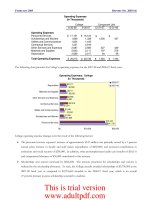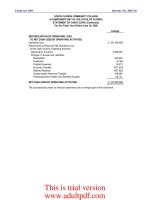REPORT NO. 2009-116 FEBRUARY 2009 SOUTH FLORIDA COMMUNITY COLLEGE _part3 pptx
Bạn đang xem bản rút gọn của tài liệu. Xem và tải ngay bản đầy đủ của tài liệu tại đây (148.18 KB, 10 trang )
FEBRUARY 2009 REPORT NO. 2009-116
-17-
College
RECONCILIATION OF OPERATING LOSS
TO NET CASH USED BY OPERATING ACTIVITIES
Operating Loss (25,166,659)$
Adjustments to Reconcile Net Operating Loss
to Net Cash Used by Operating Activities:
Depreciation Expense 2,569,087
Changes in Assets and Liabilities:
Receivables 334,432
Inventories (3,166)
Prepaid Expenses 15,673
Accounts Payable (871,518)
Deferred Revenue (427,935)
Compensated Absences Payable 169,696
Postemployment Health Care Benefits Payable 30,131
NET CASH USED BY OPERATING ACTIVITIES
(23,350,259)$
The accompanying notes to financial statements are an integral part of this statement.
SOUTH FLORIDA COMMUNITY COLLEGE
A COMPONENT UNIT OF THE STATE OF FLORID
A
STATEMENT OF CASH FLOWS (Continued)
For the Fiscal Year Ended June 30, 2008
This is trial version
www.adultpdf.com
FEBRUARY 2009 REPORT NO. 2009-116
SOUTH FLORIDA COMMUNITY COLLEGE
A COMPONENT UNIT OF THE STATE OF FLORIDA
NOTES TO FINANCIAL STATEMENTS
J
UNE 30, 2008
-18-
1. SUMMARY OF SIGNIFICANT ACCOUNTING POLICIES
Reporting Entity
. The governing body of South Florida Community College, a component unit of the
State of Florida, is the District Board of Trustees. The Board constitutes a corporation and is composed of
eight members appointed by the Governor and confirmed by the Senate. The District Board of Trustees is
under the general direction and control of the Florida Department of Education, Division of Community
Colleges, and is governed by law and State Board of Education rules. However, the District Board of
Trustees is directly responsible for the day-to-day operations and control of the College within the
framework of applicable State laws and State Board of Education rules. Geographic boundaries of the
District correspond with those of Desoto, Hardee, and Highlands Counties.
Criteria for defining the reporting entity are identified and described in the Governmental Accounting
Standards Board’s Codification of Governmental Accounting and Financial Reporting Standards, Sections 2100 and
2600. These criteria were used to evaluate potential component units for which the District Board of
Trustees is financially accountable and other organizations for which the nature and significance of their
relationship with the District Board of Trustees are such that exclusion would cause the College’s financial
statements to be misleading or incomplete. Based upon the application of these criteria, the College is a
component unit of the State of Florida, and its financial balances and activity are reported in the State’s
Comprehensive Annual Financial Report by discrete presentation.
Discretely Presented Component Unit
. Based on the application of the criteria for determining
component units, the South Florida Community College Foundation, Inc. (Foundation), is included within
the College’s reporting entity as a discretely presented component unit.
The Foundation is audited by other auditors pursuant to Section 1004.70(6), Florida Statutes. The
Foundation’s audited financial statements are available to the public at the College. The financial data
reported on the accompanying financial statements was derived from the Foundation’s audited financial
statements for the fiscal year ended December 31, 2007.
The Foundation is also a direct-support organization, as defined in Section 1004.70, Florida Statutes, and
although legally separate from the College, is financially accountable to the College. The Foundation is
managed independently, outside the College’s budgeting process, and its powers generally are vested in a
governing board pursuant to various State statutes. The Foundation receives, holds, invests, and
administers property and makes expenditures to or for the benefit of the College.
This is trial version
www.adultpdf.com
FEBRUARY 2009 REPORT NO. 2009-116
SOUTH FLORIDA COMMUNITY COLLEGE
A COMPONENT UNIT OF THE STATE OF FLORIDA
NOTES TO FINANCIAL STATEMENTS (C
ONTINUED)
J
UNE 30, 2008
-19-
Basis of Presentation
. The College’s accounting policies conform with accounting principles generally
accepted in the United States of America applicable to public colleges and universities as prescribed by the
Governmental Accounting Standards Board (GASB). The National Association of College and University
Business Officers (NACUBO) also provides the College with recommendations prescribed in accordance
with generally accepted accounting principles promulgated by GASB and the Financial Accounting
Standards Board (FASB). GASB allows public colleges various reporting options. The College has elected
to report as an entity engaged in only business-type activities. This election requires the adoption of the
accrual basis of accounting and entitywide reporting including the following components:
¾ Management’s Discussion and Analysis
¾ Basic Financial Statements:
• Statement of Net Assets
• Statement of Revenues, Expenses, and Changes in Net Assets
• Statement of Cash Flows
• Notes to Financial Statements
Basis of Accounting
. Basis of accounting refers to when revenues, expenses, and related assets and
liabilities are recognized in the accounts and reported in the financial statements. Specifically, it relates to
the timing of the measurements made, regardless of the measurement focus applied. The College’s
financial statements are presented using the economic resources measurement focus and the accrual basis
of accounting. Revenues, expenses, gains, losses, assets, and liabilities resulting from exchange and
exchange-like transactions are recognized when the exchange takes place. Revenues, expenses, gains,
losses, assets, and liabilities resulting from nonexchange activities are generally recognized when all
applicable eligibility requirements, including time requirements, are met.
The College’s component unit uses the accrual basis of accounting whereby revenues are recognized when
earned and expenses are recognized when incurred, and follows FASB standards of accounting and
financial reporting for not-for-profit organizations.
The College follows FASB statements and interpretations issued after November 30, 1989, unless those
pronouncements conflict with GASB pronouncements.
Interdepartmental sales between auxiliary service departments and other institutional departments have
been accounted for as reductions of expenses and not revenues of those departments.
This is trial version
www.adultpdf.com
FEBRUARY 2009 REPORT NO. 2009-116
SOUTH FLORIDA COMMUNITY COLLEGE
A COMPONENT UNIT OF THE STATE OF FLORIDA
NOTES TO FINANCIAL STATEMENTS (C
ONTINUED)
J
UNE 30, 2008
-20-
The College’s principal operating activity is instruction. Operating revenues and expenses generally include
all fiscal transactions directly related to instruction as well as administration, academic support, student
services, physical plant operations, and depreciation of capital assets. Nonoperating revenues include State
appropriations, Federal and State student financial aid, investment income (net of unrealized gains or losses
on investments), and revenues for capital construction projects. Interest on capital asset-related debt is
considered a nonoperating expense.
The statement of net assets is presented in a classified format to distinguish between current and
noncurrent assets and liabilities. When both restricted and unrestricted resources are available to fund
certain programs, it is the College’s policy to first apply the restricted resources to such programs followed
by the use of the unrestricted resources.
The statement of revenues, expenses, and changes in net assets is presented by major sources and is
reported net of tuition scholarship allowances. Tuition scholarship allowances are the differences between
the stated charge for goods and services provided by the College and the amount that is actually paid by
the student or the third party making payment on behalf of the student. To the extent that these resources
are used to pay student charges, the College records a scholarship allowance against tuition and fee
revenues.
The statement of cash flows is presented using the direct method in compliance with GASB Statement
No. 9, Reporting Cash Flows for Proprietary and Nonexpendable Trust Funds and Governmental Entities That Use
Proprietary Fund Accounting.
Cash and Cash Equivalents
. The amount reported as cash and cash equivalents consists of cash on
hand, cash in demand accounts, and cash with the State Board of Administration Local Government
Surplus Funds Trust Fund Investment Pool (LGIP). For the purpose of reporting cash flows, the College
considers all highly liquid investments with original maturities of three months or less to be cash
equivalents. Under this definition, the College considers amounts invested in the LGIP to be cash
equivalents. College cash deposits are held in banks qualified as public depositories under Florida law. All
such deposits are insured by Federal depository insurance, up to specified limits, or collateralized with
securities held in Florida’s multiple financial institution collateral pool required by Chapter 280, Florida
Statutes. Cash and cash equivalents that are externally restricted to purchase or construct capital or other
restricted assets are classified as restricted.
At June 30, 2008, the College reported as cash equivalents at fair value $1,773 of moneys held in the LGIP
administered by the State Board of Administration (SBA) pursuant to Section 218.405, Florida Statutes.
This is trial version
www.adultpdf.com
FEBRUARY 2009 REPORT NO. 2009-116
SOUTH FLORIDA COMMUNITY COLLEGE
A COMPONENT UNIT OF THE STATE OF FLORIDA
NOTES TO FINANCIAL STATEMENTS (C
ONTINUED)
J
UNE 30, 2008
-21-
The College’s investments in the LGIP, which SBA indicates is a Securities and Exchange Commission
Rule 2a7-like external investment pool at June 30, 2008, are similar to money market funds in which shares
are owned in the fund rather than the underlying investments. The LGIP carried a credit rating of AAAm
by Standard and Poor’s and had a weighted-average days to maturity (WAM) of 20.22 days at
June 30, 2008. A portfolio’s WAM reflects the average maturity in days based on final maturity or reset
date, in the case of floating rate instruments. WAM measures the sensitivity of the LGIP to interest rate
changes. The investments are reported at fair value, which is amortized cost.
Capital Assets
. College capital assets consist of land; artwork; construction in progress; buildings; other
structures and improvements; and furniture, machinery, and equipment. These assets are capitalized and
recorded at cost at the date of acquisition or at estimated fair value at the date received in the case of gifts
and purchases of State surplus property. Additions, improvements, and other outlays that significantly
extend the useful life of an asset are capitalized. Other costs incurred for repairs and maintenance are
expensed as incurred. The College has a capitalization threshold of $5,000 for tangible personal property
and $25,000 for buildings and other structures and improvements. Depreciation is computed on the
straight-line basis over the following estimated useful lives:
¾ Buildings – 40 years
¾ Other Structures and Improvements – 10 years
¾ Furniture and Equipment:
• Computer Equipment – 3 years
• Vehicles, Office Machines, Educational Equipment – 5 years
• Furniture – 7 years
Land, buildings, and equipment of the College’s component unit are stated at cost except for donated
property which is stated at fair market value at the date of the donation, and is net of accumulated
depreciation of $510,536. The College’s component unit depreciates buildings and equipment using the
straight-line method.
2. INVESTMENTS
The College’s Board of Trustees had not adopted a written investment policy. As such, pursuant to
Section 218.415(17), Florida Statutes, the College is authorized to invest in the Local Government Surplus
Funds Trust Fund investment pools administered by the State Board of Administration; interest-bearing
time deposits and savings accounts in qualified public depositories, as defined by Section 280.02, Florida
Statutes; direct obligations of the United States Treasury; obligations of Federal agencies and
This is trial version
www.adultpdf.com
FEBRUARY 2009 REPORT NO. 2009-116
SOUTH FLORIDA COMMUNITY COLLEGE
A COMPONENT UNIT OF THE STATE OF FLORIDA
NOTES TO FINANCIAL STATEMENTS (C
ONTINUED)
J
UNE 30, 2008
-22-
instrumentalities; and Securities and Exchange Commission registered money market funds with the
highest credit quality rating from a nationally recognized rating agency; and other investments approved by
the College’s Board of Trustees as authorized by law. State Board of Education Rule 6A-14.0765(3),
Florida Administrative Code, provides that College loan, endowment, annuity, and life income funds may
also be invested pursuant to Section 215.47, Florida Statutes. Investments authorized by Section 215.47,
Florida Statutes, include bonds, notes, commercial paper, and various other types of investments.
Investments set aside to make debt service payments, maintain sinking or reserve funds, or to purchase or
construct capital assets are classified as restricted.
The College reported no investments at June 30, 2008, as surplus funds were invested with the State Board
of Administration Fund Local Government Surplus Funds Trust Fund Investment Pool, and were
reported as cash and cash equivalents.
Component Unit Investments
Investments of the College’s component unit at December 31, 2007, consist of equity investments, money
market, and mutual funds totaling $7,534,433, and are reported at fair value.
3. ACCOUNTS RECEIVABLE
Accounts receivable represent amounts for student fee deferments, various student and administrative
services provided by the College, uncollected vending commissions, unused credit memos, and contract
and grant reimbursements due from third parties. The College considers these receivables to be fully
collectible.
4. DUE FROM OTHER GOVERNMENTAL AGENCIES
This amount primarily consists of $5,656,252 of Public Education Capital Outlay allocations due from the
State for construction of College facilities.
5. DUE FROM COMPONENT UNIT
The $56,738 reported as due from the component unit primarily consists of amounts owed to the College
by the Foundation pursuant to an agreement to support the Foundation’s operations. The College’s
financial statements are reported for the fiscal year ended June 30, 2008. The College’s component unit’s
financial statements are reported for the fiscal year ended December 31, 2007. Accordingly, amounts
reported by the College as due from the component unit on the statement of net assets, has no
corresponding amount reported for the component unit as payable to the College.
This is trial version
www.adultpdf.com
FEBRUARY 2009 REPORT NO. 2009-116
SOUTH FLORIDA COMMUNITY COLLEGE
A COMPONENT UNIT OF THE STATE OF FLORIDA
NOTES TO FINANCIAL STATEMENTS (C
ONTINUED)
J
UNE 30, 2008
-23-
6. INVENTORIES
Inventories consist of items for resale by the College and purchased food, and are valued using the last
invoice cost, which approximates the first-in, first-out, method of inventory valuation. Consumable
laboratory supplies, teaching materials, and office supplies on hand in College departments are expensed
when purchased, and are not considered material. Accordingly, these items are not included in the
reported inventory.
7. CAPITAL ASSETS
Capital assets activity for the fiscal year ended June 30, 2008, is shown below:
Description Beginning Additions Reductions Ending
Balance Balance
Nondepreciable Capital Assets:
Land 2,477,518$ 2,477,518$
Artwork 401,263 2,100 403,363
Construction in Progress 10,554,602 4,567,709 11,746,510 3,375,801
Total Nondepreciable Capital Assets
13,433,383$ 4,569,809$ 11,746,510$ 6,256,682$
Depreciable Capital Assets:
Buildings 56,441,510$ 9,910,015$ 1,476,418$ 64,875,107$
Other Structures and Improvements 9,540,677 2,359,637 309,154 11,591,160
Furniture, Machinery, and Equipment 2,752,911 248,616 131,488 2,870,039
Total Depreciable Capital Assets
68,735,098 12,518,268 1,917,060 79,336,306
Less, Accumulated Depreciation:
Buildings 17,636,498 1,483,070 1,936,035 17,183,533
Other Structures and Improvements 6,878,330 792,554 185,493 7,485,391
Furniture, Machinery, and Equipment 2,155,766 293,463 130,313 2,318,916
Total Accumulated Depreciation
26,670,594 2,569,087 2,251,841 26,987,840
Total Depreciable Capital Assets, Net
42,064,504$ 9,949,181$ (334,781)$ 52,348,466$
$ $
8. ART COLLECTIONS
In addition to the Museum of Florida Art and Culture (MOFAC) collection, which is capitalized and not
depreciated, the College has the McDearman collection that it does not capitalize. The MOFAC collection
adheres to the College’s policy to: (a) maintain them for public exhibition, education, or research;
(b) protect, keep unencumbered, care for, and preserve them; and (c) require proceeds from their sale to be
used to acquire other collection items. Generally accepted accounting principles permit noncapitalized
This is trial version
www.adultpdf.com
FEBRUARY 2009 REPORT NO. 2009-116
SOUTH FLORIDA COMMUNITY COLLEGE
A COMPONENT UNIT OF THE STATE OF FLORIDA
NOTES TO FINANCIAL STATEMENTS (C
ONTINUED)
J
UNE 30, 2008
-24-
collections like the McDearman collection to be charged to operations at the time of purchase rather than
capitalized.
9. DEFERRED REVENUE
Deferred revenue of $427,028 consists primarily of advance ticket sales of $321,145 on the College’s
2008-09 cultural events series.
10. LONG-TERM LIABILITIES
Long-term liabilities of the College at June 30, 2008, include compensated absences and postemployment
health care benefits payable. Long-term liabilities activity for the fiscal year ended June 30, 2008, is shown
below:
Description Beginning Additions Reductions Ending Current
Balance Balance Portion
Compensated Absences Payable 1,806,192$ 260,343$ 90,647$ 1,975,888$ 90,647$
Postemployment Health Care
Benefits Payable 64,617 34,486 30,131
Total Long-Term Liabilities
1,806,192$ 324,960$ 125,133$ 2,006,019$ 90,647$
11. COMPENSATED ABSENCES PAYABLE
College employees may accrue annual and sick leave based on length of service, subject to certain
limitations regarding the amount that will be paid upon termination. The College reports a liability for the
accrued leave; however, State appropriations fund only the portion of accrued leave that is used or paid in
the current fiscal year. Although the College expects the liability to be funded primarily from future
appropriations, generally accepted accounting principles do not permit the recording of a receivable in
anticipation of future appropriations. At June 30, 2008, the estimated liability for compensated absences,
which includes the College’s share of the Florida Retirement System and FICA contributions, totaled
$1,975,888. The current portion of the compensated absences liability is the amount expected to be paid in
the coming fiscal year, and represents payments for employees in the final year of the Deferred Retirement
Option Program.
12. POSTEMPLOYMENT HEALTH CARE BENEFITS PAYABLE
Effective for the 2007-08 fiscal year, the College implemented Governmental Accounting Standards Board
Statement No. 45, Accounting and Financial Reporting by Employers for Postemployment Benefits Other Than Pensions,
for certain postemployment health care benefits provided by the College via the Florida Community
College Risk Management Consortium (Consortium). The requirements of this Statement are being
This is trial version
www.adultpdf.com
FEBRUARY 2009 REPORT NO. 2009-116
SOUTH FLORIDA COMMUNITY COLLEGE
A COMPONENT UNIT OF THE STATE OF FLORIDA
NOTES TO FINANCIAL STATEMENTS (C
ONTINUED)
J
UNE 30, 2008
-25-
implemented prospectively, with the actuarially determined liability of $537,140 at the July 1, 2007, date of
transition amortized over 30 years. Accordingly, for financial reporting purposes, no liability is reported
for the postemployment health care benefits liability at the date of transition.
Plan Description
. The College contributes to a cost-sharing, multiple-employer, defined benefit health
care plan administered by the Consortium. Pursuant to the provisions of Section 112.0801, Florida
Statutes, former employees who retire from the College are eligible to participate in the Consortium for
health care benefits. The College subsidizes the premium rates paid by retirees by allowing them to
participate in the plan at reduced or blended group (implicitly subsidized) premium rates for both active
and retired employees. These rates provide an implicit subsidy for retirees because, on an actuarial basis,
their current and future claims are expected to result in higher costs to the plan on average than those of
active employees. The College does not offer any explicit subsidies. Retirees are required to enroll in the
Federal Medicare program for their primary health coverage as soon as they are eligible. The Consortium
does not issue a stand-alone report and is not included in the annual report of a public employee
retirement system or another entity.
Funding Policy
. Benefit provisions are pursuant to provisions of Section 112.0801, Florida Statutes, and
benefits can be amended by the Board of Trustees. The College has not advance-funded or established a
funding methodology for the annual Other Postemployment Benefit (OPEB) costs or the net OPEB
obligation. For the 2007-08 fiscal year, 55 retirees received postemployment health care benefits. The
College provided required contributions of $34,486 toward the annual OPEB cost, comprised of the
actuarially determined premium payments for retirees, net of retiree contributions totaling $209,396.
Annual OPEB Cost and Net OPEB Obligation
. The College’s annual OPEB cost (expense) is
calculated based on the annual required contribution (ARC), an amount actuarially determined in
accordance with the parameters of Governmental Accounting Standards Board Statement No. 45,
Accounting and Financial Reporting by Employers for Postemployment Benefits Other Than Pensions. The ARC
represents a level of funding that if paid on an ongoing basis, is projected to cover normal cost each year
and amortize any unfunded actuarial liabilities over a period not to exceed 30 years. The following table
shows the College’s annual OPEB cost for the year, the amount actually contributed to the plan, and
changes in the College’s net OPEB obligation:
This is trial version
www.adultpdf.com
FEBRUARY 2009 REPORT NO. 2009-116
SOUTH FLORIDA COMMUNITY COLLEGE
A COMPONENT UNIT OF THE STATE OF FLORIDA
NOTES TO FINANCIAL STATEMENTS (C
ONTINUED)
J
UNE 30, 2008
-26-
Description Amount
Normal Cost (Service Cost for One Year) 46,712$
Amortization of Unfunded Actuarial:
Accrued Liability 17,905
Interest on Normal Cost and Amortization -
Annual Required Contribution
64,617
Interest on Net OPEB Obligation -
Adjustment to Annual Required Contribution -
Annual OPEB Cost (Expense)
64,617
Contribution Toward the OPEB Cost (34,486)
Increase in Net OPEB Obligation
30,131
Net OPEB Obligation, Beginning of Year -
Net OPEB Obligation, End of Year
30,131$
The College’s annual OPEB cost, the percentage of annual OPEB cost contributed to the plan, and the net
OPEB obligation as of June 30, 2008 (year of implementation), was as follows:
Fiscal Yea
r
A
nnual Percenta
g
e of Net OPEB
OPEB Cost
A
nnual Obli
g
ation
OPEB Cost
Contributed
Be
g
innin
g
Balance, Jul
y
1, 2007 $ $
2007-0
8
64,617 53.4% 30,131
Funded Status and Funding Progress
. As of June 30, 2008, the actuarial accrued liability for benefits
was $537,140, and the actuarial value of assets was $0, resulting in an unfunded actuarial accrued liability of
$537,140. The covered payroll (annual payroll of active participating employees) was $17,151,444 for the
2007-08 fiscal year, and the ratio of the unfunded actuarial accrued liability to the covered payroll was
3.1 percent.
Actuarial Methods and Assumptions
. Actuarial valuations of an ongoing plan involve estimates of the
value of reported amounts and assumptions about the probability of occurrence of events far into the
future. Examples include assumptions about future employment and termination, mortality, and the
healthcare cost trends. Amounts determined regarding the funded status of the plan and the annual
required contributions of the employer are subject to continual revision as actual results are compared with
past expectations and new estimates are made about the future. Projections of benefits for financial
reporting purposes are based on the substantive plan provisions, as understood by the employer and
participating members, and include the types of benefits provided at the time of each valuation and the
This is trial version
www.adultpdf.com









